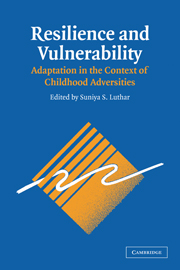Book contents
- Frontmatter
- Contents
- List of Contributors
- Foreword by Dante Cicchetti
- Preface
- 1 A Resilience Framework for Research, Policy, and Practice
- PART I FAMILIAL ADVERSITIES: PARENTAL PSYCHOPATHOLOGY AND FAMILY PROCESSES
- PART II EXOSYSTEMIC AND SOCIODEMOGRAPHIC RISKS
- PART III COMMENTARIES
- 19 Toward Building a Better Brain: Neurobehavioral Outcomes, Mechanisms, and Processes of Environmental Enrichment
- 20 Genetic Influences on Risk and Protection: Implications for Understanding Resilience
- 21 Research on Resilience: An Integrative Review
- Index
- References
21 - Research on Resilience: An Integrative Review
Published online by Cambridge University Press: 05 June 2012
- Frontmatter
- Contents
- List of Contributors
- Foreword by Dante Cicchetti
- Preface
- 1 A Resilience Framework for Research, Policy, and Practice
- PART I FAMILIAL ADVERSITIES: PARENTAL PSYCHOPATHOLOGY AND FAMILY PROCESSES
- PART II EXOSYSTEMIC AND SOCIODEMOGRAPHIC RISKS
- PART III COMMENTARIES
- 19 Toward Building a Better Brain: Neurobehavioral Outcomes, Mechanisms, and Processes of Environmental Enrichment
- 20 Genetic Influences on Risk and Protection: Implications for Understanding Resilience
- 21 Research on Resilience: An Integrative Review
- Index
- References
Summary
The contributors to this volume have provided a wealth of information on children facing different life adversities, and in this concluding chapter we provide a distillation of two sets of themes. The first encompasses conceptual and methodological issues in studies of resilience – which, as defined in this book, is a process or phenomenon reflecting positive child adjustment despite conditions of risk. Since its inception a few decades ago, various commentaries have led to refinements in the research on resilience, yet several important issues have remained either unclear or controversial. The introductory chapter of this volume provides a succinct summary of this field at its initiation. In this chapter, we draw from the cutting-edge research presented throughout this book to clarify critical issues in studying resilience, with the ultimate goal of maximizing the contributions of future work on this construct. In turn, we consider (a) distinctions between the risk and resilience paradigms; (b) approaches to measuring adversity and competence; and (c) various concerns about protective and vulnerability factors, including the differences between them, issues about the specificity of effects, and the types of issues most usefully examined in future studies.
Contrasting with the focus on empirical research in the first half of this chapter, the second half is focused on applied issues. At the heart of much resilience research is the desire to uncover salient protective and vulnerability processes that, if targeted in interventions, would substantially improve at-risk children's odds of doing well in life.
- Type
- Chapter
- Information
- Resilience and VulnerabilityAdaptation in the Context of Childhood Adversities, pp. 510 - 550Publisher: Cambridge University PressPrint publication year: 2003
References
- 226
- Cited by



